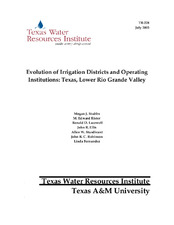Evolution of Irrigation Districts and Operating Institutions: Texas, Lower Rio Grande Valley
Abstract
The growing population in the Texas Lower Rio Grande Valley, shortfalls
in water deliveries from Mexico, and multiple years of drought have placed an
increased need for efficient water management and allocation in the Rio Grande
Basin. These improvements are essential regardless of the treaty compliance
issues between Mexico and the U.S. for improved water deliveries to satisfy the
1944 Water Treaty. This report presents a broad overview of how the history of
settlement and development shaped current water rights and laws, how the
waters of the Rio Grande are divided between the two nations, and how the U.S.
and the State of Texas manage their portions. Legal rules and regulations, both
current and past, represent the complexity of water allocated in the region. The
paper overviews characteristics of the 1944 International Water Treaty and
management of Amistad and Falcon international reservoirs by the International
Boundary and Water Commission. This overview provides insight on history and
the basics of the current set of water allocations, rules and regulations, and some
discussion of evolving institutions, i.e., water authorities. Knowledge of the
background of the region facilitates ongoing water management policy
deliberations, revision/development of policies, and future management of limited
water resources. A review of selected Rio Grande Basin irrigation districts and
associated operating principles will follow in subsequent reports.
Collections
Citation
Fernandez, Linda; Robinson, John R.C.; Lacewell, Ronald D.; Rister, M. Edward; Ellis, John R.; Sturdivant, Allen W.; Stubbs, Megan J. (2003). Evolution of Irrigation Districts and Operating Institutions: Texas, Lower Rio Grande Valley. Texas Water Resources Institute. Available electronically from https : / /hdl .handle .net /1969 .1 /6119.


